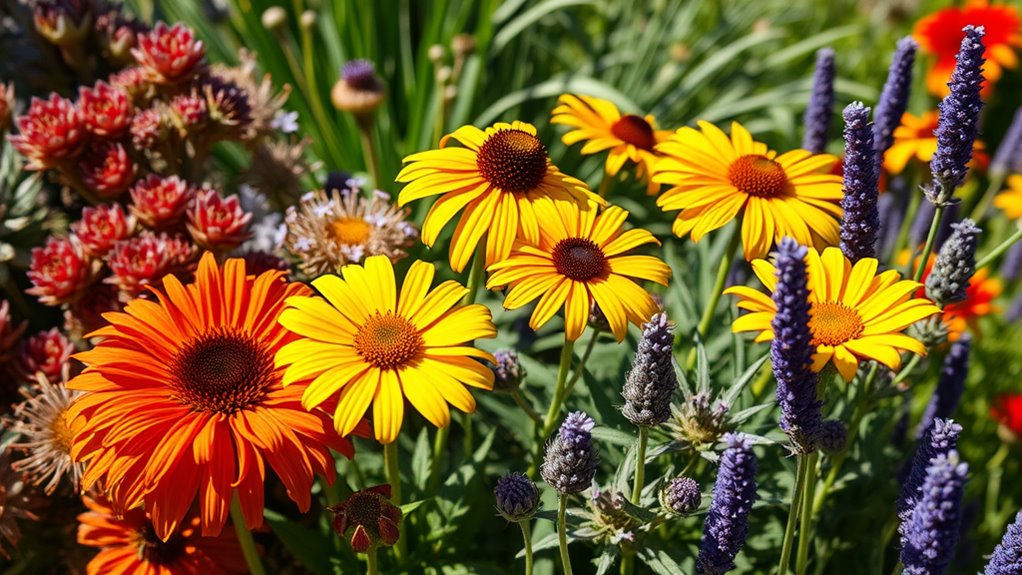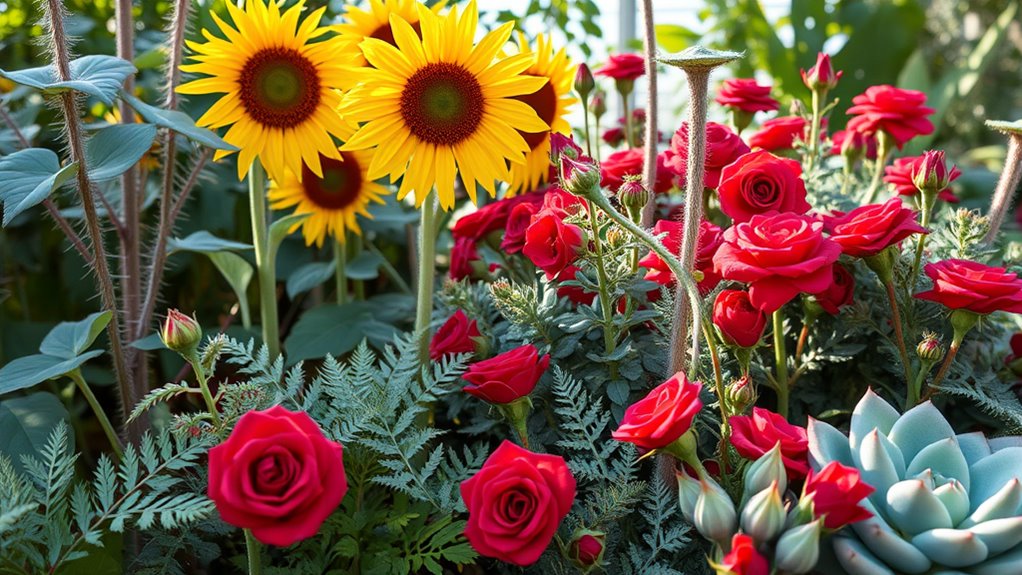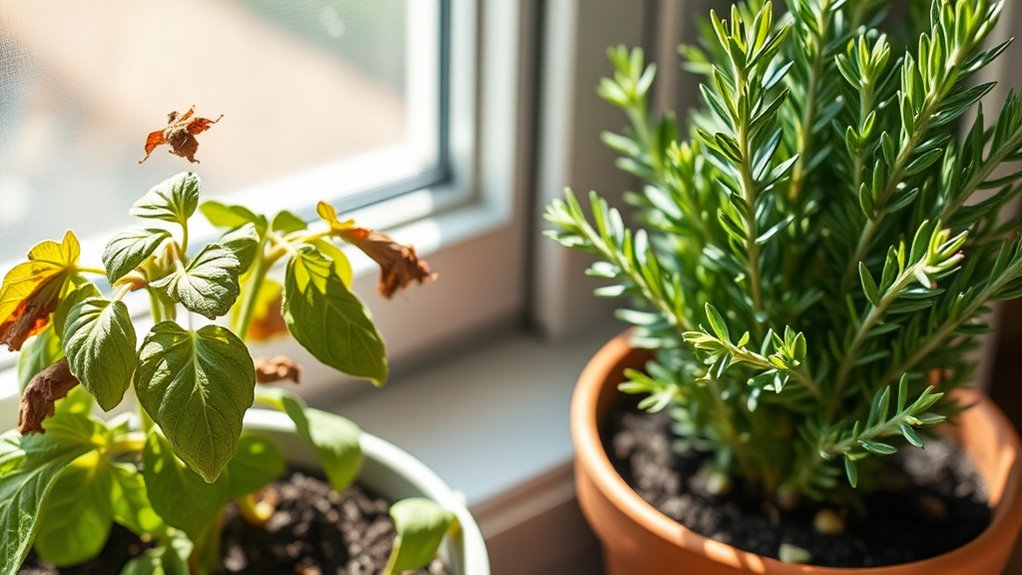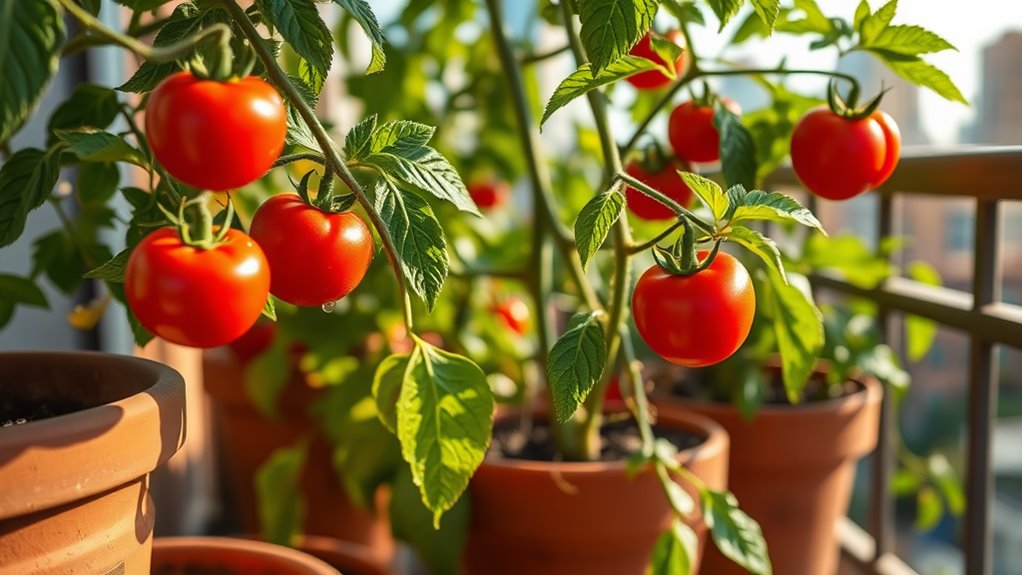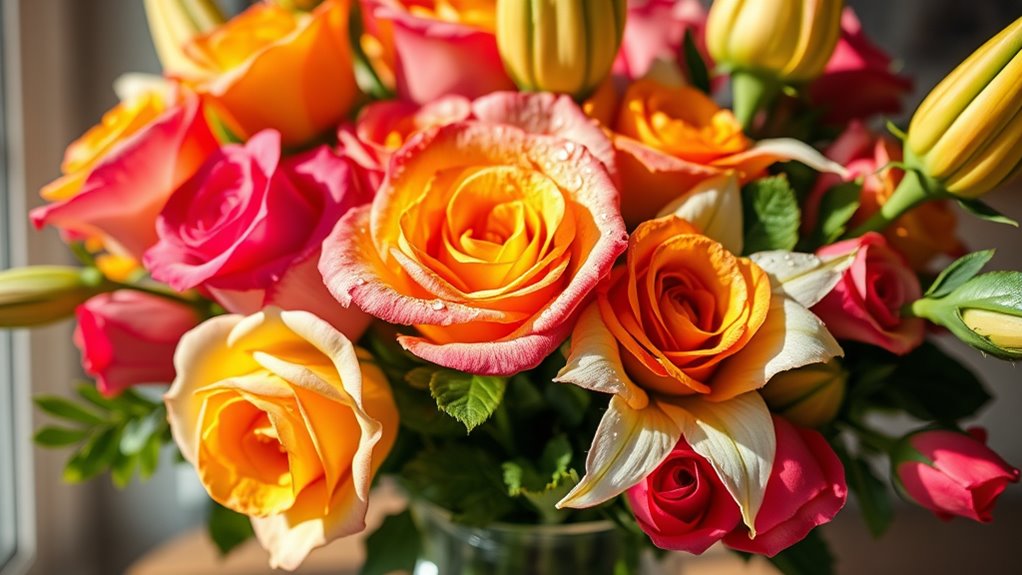7 Flower Varieties That Practically Water Themselves
You can effortlessly grow these seven drought-tolerant flowers that practically water themselves: lavender, coneflower, black-eyed Susan, yarrow, Russian sage, blanket flower, and sedum. They’ll thrive in dry conditions, adding vibrant colors and attracting bees and butterflies to your garden with minimal effort. Save time and enjoy a buzzing ecosystem while exploring more tips to boost your low-maintenance paradise.
Key Takeaways
- Lavender requires minimal watering and thrives in dry, sunny spots, producing fragrant purple blooms.
- Coneflower withstands droughts with deep roots, attracting bees and butterflies while needing little care.
- Black-eyed Susan flourishes in parched soil, offering bright yellow flowers with low water demands.
- Yarrow grows prolifically in poor, dry conditions, blooming vibrantly with infrequent irrigation.
- Russian Sage tolerates arid environments, providing elegant blue flowers and resisting wilting easily.
Lavender
Lavender thrives in dry conditions, making it a perfect choice for gardens that demand less watering.
As one of the top low-maintenance flowers, it adapts effortlessly to sunny, well-drained spots, requiring minimal fuss from you.
You’ll enjoy its drought resistance, which means you can skip frequent irrigation while it flourishes beautifully.
Lavender also thrives in poor soil conditions, enhancing its appeal for various garden settings.
This hardy plant blooms with vibrant purple spikes, attracting pollinators and filling your space with a calming fragrance.
Lavender is one of the seven varieties explored in this guide to effortless blooms.
Coneflower
You love coneflowers for their impressive drought tolerance, letting you skip frequent watering while they thrive in tough conditions.
You’ll find their easy maintenance keeps your garden hassle-free, requiring minimal effort to keep them blooming beautifully.
Plus, these vibrant flowers attract pollinators like bees and butterflies, turning your space into a buzzing haven of wildlife.
Additionally, in extreme heat, using heat-proof techniques can help ensure they remain hydrated and healthy without excess water.
To further support their growth, incorporating expert watering techniques can help maintain optimal conditions without overwatering.
Drought Tolerance
Coneflowers excel in drought-prone gardens, thriving with minimal water thanks to their deep root systems that tap into hidden moisture reserves.
You’ll love how these hardy perennials resist wilting during hot spells, drawing nutrients from far below the soil surface.
This natural adaptation means you can plant them in sandy or rocky spots where other flowers fail, saving you effort while they bloom vibrantly.
Their resilience boosts your garden’s beauty with daisy-like flowers in vibrant hues, attracting pollinators effortlessly.
Embrace coneflowers for a low-water oasis that withstands dry seasons with ease!
Easy Maintenance
While coneflowers thrive with minimal effort, you’ll appreciate their straightforward care routine that keeps them blooming beautifully.
Plant them in well-drained soil and full sun for optimal growth, and they’ll handle the rest with ease. Deadhead faded flowers to promote more blooms, but skip heavy pruning—they’re naturally resilient.
Water sparingly once established, as they tolerate dry spells well, and use minimal fertilizer to avoid overwhelming them.
Their disease resistance means fewer worries, letting you enjoy vibrant colors and sturdy stems without constant attention.
Embrace this low-fuss favorite for effortless garden joy!
Pollinator Attraction
Beyond their straightforward care, coneflowers draw in bees, butterflies, and birds with their nectar-rich blooms. You’ll watch your garden thrive as these visitors enhance pollination, boosting yields and adding lively movement. They make your space a buzzing ecosystem, effortlessly supporting biodiversity.
| Pollinator | Attraction Feature | Garden Benefit |
|---|---|---|
| Bees | Abundant nectar | Improved pollination |
| Butterflies | Vibrant petals | Enhanced aesthetics |
| Birds | Seed heads | Natural pest control |
Embrace coneflowers; you’re creating a self-sustaining haven that’s as rewarding as it is low-maintenance!
Black-eyed Susan
You love how Black-eyed Susan thrives with minimal effort, making it a perfect drought-tolerant flower for your garden.
Its low water needs mean you’re saving time and resources while enjoying vibrant blooms all season.
Imagine adding this resilient beauty to your landscape, where it practically waters itself through its hardy nature!
Drought Tolerant
One standout flower for drought-tolerant landscapes is the Black-eyed Susan, a resilient perennial that thrives with minimal water.
You’ll appreciate how it withstands scorching summers and parched soil, thanks to its deep root system that efficiently scavenges moisture.
This vibrant bloomer produces cheerful yellow daisy-like flowers that brighten your garden from mid-summer onward, drawing in beneficial pollinators without demanding extra care.
Plant it in well-drained spots for optimal growth, and you’ll enjoy its hardy nature year after year, turning dry areas into lively, low-maintenance havens that save you time and effort.
Low Water Needs
Black-eyed Susan excels in low water needs, thriving in dry conditions thanks to its deep roots that efficiently draw moisture from the soil.
You’ll find it perfect for your low-maintenance garden, as it adapts easily to poor soils and attracts pollinators without constant watering.
-
Vibrant blooms: Enjoy bright yellow flowers that cheer up your space all summer.
-
Drought resistance: Watch it bounce back quickly after dry spells, saving you time.
-
Easy propagation: Start your own plants from seeds you collect effortlessly.
-
Wildlife appeal: Invite butterflies and birds to enhance your garden’s ecosystem.
-
Versatile growth: Plant it in borders or meadows for a natural, effortless look.
Yarrow
Yarrow, with its feathery foliage and clusters of bright, flat-topped flowers, thrives in dry conditions that challenge other plants.
You’ll appreciate how this resilient perennial demands little water, making it perfect for your drought-prone garden.
Once established, it grows vigorously in poor soil with minimal care, blooming prolifically to add vibrant color and texture.
You can easily propagate it from divisions or seeds, ensuring long-lasting displays that attract beneficial pollinators.
Its adaptability lets you incorporate it into sunny borders or wildflower mixes, saving you time while enhancing your landscape’s natural beauty.
This feature makes it suitable for busy lifestyles, allowing you to maintain a vibrant garden effortlessly.
Embrace Yarrow for effortless gardening joy!
Beyond its ornamental value, Yarrow can also act as an unconventional remedy to help naturally control pests in your garden.
Russian Sage
Russian Sage brings airy elegance to your drought-tolerant garden with its silvery foliage and spires of lavender-blue flowers that thrive on little water.
You’ll enjoy its low-maintenance charm, as it adapts easily to dry soils and brings pollinators to your yard. Using mulch for moisture retention can further support its growth by conserving soil moisture and suppressing weeds.
-
Boosts biodiversity: Attracts bees and butterflies, enhancing your garden’s ecosystem.
-
Handles heat well: Tolerates hot, arid conditions without wilting, saving you effort.
-
Grows vigorously: Reaches 3-5 feet, creating stunning borders or backdrops.
-
Blooms prolifically: Produces flowers from summer through fall for extended color.
-
Needs little care: Prune in spring to encourage bushy growth and skip frequent watering.
To enhance its growth naturally, consider applying organic tips for a healthier, chemical-free garden.
Blanket Flower
Blanket Flower bursts onto your drought-resistant garden with vibrant, daisy-like blooms in fiery reds and yellows that thrive on scant water.
You’ll love how this hardy perennial withstands heat and poor soil, blooming prolifically from summer into fall with minimal care.
It’s perfect for attracting pollinators like bees and butterflies, adding lively color to your landscape.
Plant it in full sun, and you’ll enjoy its drought tolerance—once established, it rarely needs watering, saving you time and effort while creating a stunning, low-maintenance display that brightens your outdoor space.
This plant can help achieve year-round blooms when combined with other seasonal varieties for continuous garden vibrancy.
To extend its appeal across seasons, consider how Blanket Flower fits into effortless seasonal tips for a year-round colorful garden.
Sedum
Sedum adds resilient charm to your drought-resistant garden with its fleshy leaves and star-shaped flowers that handle neglect like a pro. You’ll thrive with this low-maintenance succulent, as it stores water efficiently and bounces back from dry spells, adding vibrant hues to your landscape. To maximize your Sedum’s potential, try implementing organic hacks for even better plant health and sustainability.
-
Boost your garden’s diversity: Sedum offers over 600 varieties, from creeping ground covers to tall perennials, letting you mix textures effortlessly.
-
Simplify watering routines: It requires minimal irrigation, thriving in well-drained soil and enduring heat waves without fuss.
-
Enhance pollinator appeal: These flowers attract bees and butterflies, turning your yard into a buzzing haven.
-
Ease propagation efforts: Cut stems root quickly in soil, so you’re multiplying plants in no time.
-
Promote soil health: Sedum prevents erosion on slopes, making your garden more resilient and eco-friendly.
To further enhance your Sedum’s vitality, consider incorporating organic fertilizer into your gardening routine for bigger, stronger plants.

